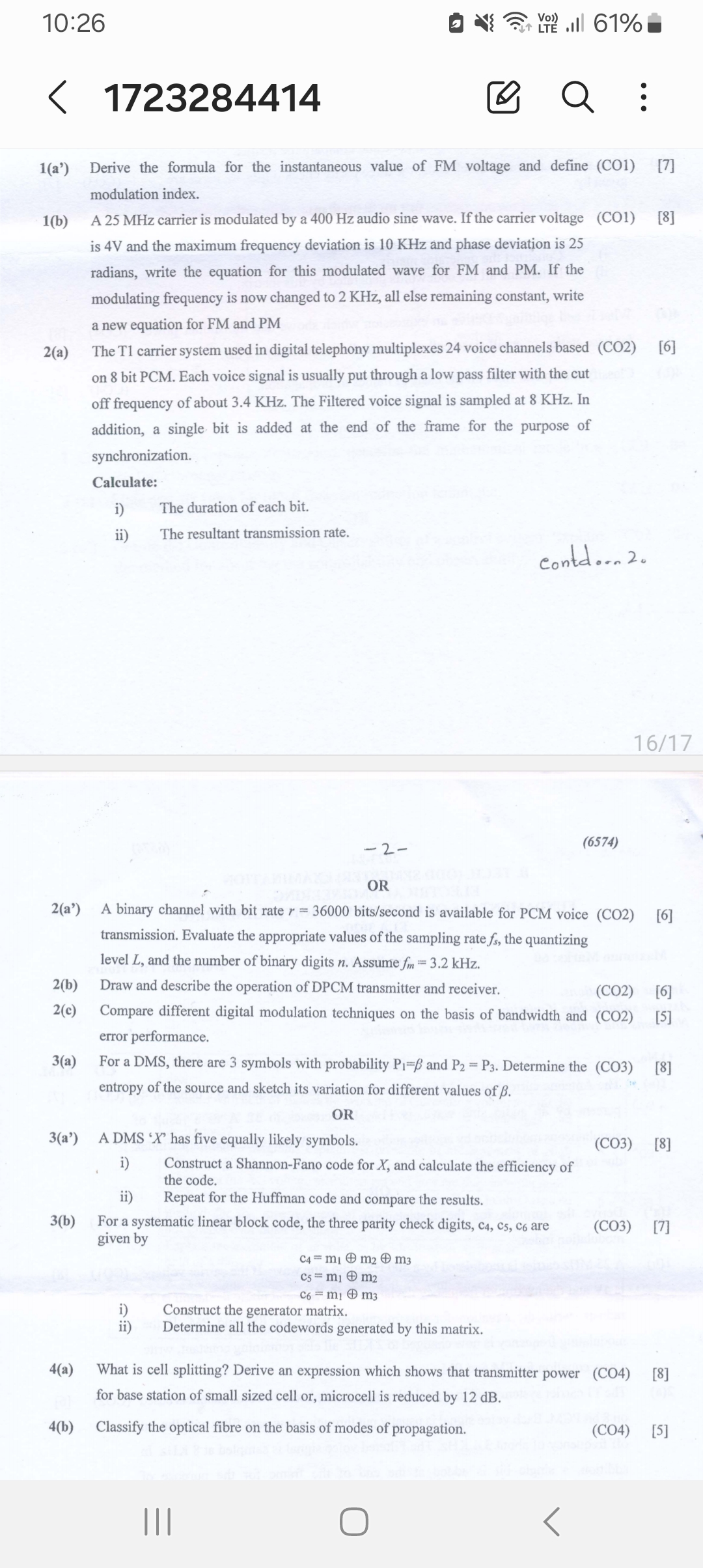1(a) Derive the formula for the instantaneous value of FM voltage and define modulation index. 1(b) A 25 MHz carrier is modulated by a 400 Hz audio sine wave. If the carrier voltag... 1(a) Derive the formula for the instantaneous value of FM voltage and define modulation index. 1(b) A 25 MHz carrier is modulated by a 400 Hz audio sine wave. If the carrier voltage is 4V and the maximum frequency deviation is 10 kHz and phase deviation is 25 radians, write the equation for this modulated wave for FM and PM. If the modulating frequency changes to 2 kHz, write a new equation for FM and PM. 2(a) Calculate the duration of each bit and resultant transmission rate for a T1 carrier system sampling a voice signal at 8 Khz and using 8 bit PCM. 2(b) Evaluate the appropriate values for a binary channel with a bit rate of 36000 bits/second for PCM voice and assume specific parameters. 2(c) Compare digital modulation techniques based on error performance. 3(a) Construct Shannon-Fano and Huffman codes for a DMS with five symbols and calculate efficiencies. 3(b) Construct the generator matrix for a systematic linear block code. 4(a) Derive an expression for cell splitting in relation to transmitter power. 4(b) Classify optical fibre based on modes of propagation.

Understand the Problem
The question contains multiple parts related to communications engineering, including derivation of formulas for FM voltage, modulation techniques, and digital transmission concepts. It asks for calculations, explanations, and comparisons of methods in telecommunications.
Answer
FM: V(t) = 4 * sin(2π*25*10^6*t + 10^4*sin(2π*400*t)). PM: V(t) = 4 * sin(2π*25*10^6*t + 25*sin(2π*400*t)).
1(a) The instantaneous FM voltage is given by: V(t) = Vc * sin(2πfct + βsin(2πfmt)) where Vc is the carrier voltage, fc is the carrier frequency, β is the modulation index, and fm is the modulating frequency.
The modulation index (β) is defined as the ratio of the frequency deviation (Δf) to the modulating frequency (fm).
1(b) For FM: V(t) = 4 * sin(2π2510^6t + 10^4sin(2π400t)) For PM: V(t) = 4 * sin(2π2510^6t + 25sin(2π400t))
If fm = 2 kHz: FM: V(t) = 4 * sin(2π2510^6t + 10^4sin(2π2000t)) PM: V(t) = 4 * sin(2π2510^6t + 25sin(2π2000t))
Answer for screen readers
1(a) The instantaneous FM voltage is given by: V(t) = Vc * sin(2πfct + βsin(2πfmt)) where Vc is the carrier voltage, fc is the carrier frequency, β is the modulation index, and fm is the modulating frequency.
The modulation index (β) is defined as the ratio of the frequency deviation (Δf) to the modulating frequency (fm).
1(b) For FM: V(t) = 4 * sin(2π2510^6t + 10^4sin(2π400t)) For PM: V(t) = 4 * sin(2π2510^6t + 25sin(2π400t))
If fm = 2 kHz: FM: V(t) = 4 * sin(2π2510^6t + 10^4sin(2π2000t)) PM: V(t) = 4 * sin(2π2510^6t + 25sin(2π2000t))
More Information
The FM and PM modulated wave equations change with different modulating frequencies, affecting the frequencies they utilize.
Tips
A common mistake is incorrectly applying the modulation index, which affects the deviation calculations.
Sources
- Derive the formula for the instantaneous value of an FM voltage and... - transtutors.com
AI-generated content may contain errors. Please verify critical information